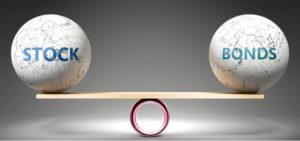
With years of stock bull markets behind investors, it’s no surprise that equities are a large part of many portfolios. But as investors get older, it’s important to balance their holdings with bonds. How do they know when their stock portfolio is too large for their age? Anne Tergesen explains in The Wall Street Journal:
Older investors’ decision to keep so much in stocks is facing a test right now. Major market indexes all declined sharply in the past week, with the Nasdaq Composite entering a correction. Intraday trading has seen the S&P 500 swing more than 3% some days.
Despite the wider selloff and volatility, baby boomers, born between 1946 and 1964, appear unlikely to sell too much of their stock portfolios, say advisers and other financial planners. They say that many older Americans are emboldened by relatively quick recoveries from the bear markets of the early 2000s and 2020. And many people still don’t see anywhere else to smartly invest.
“Some feel almost ho-hum about stock-market volatility,” said Paul Auslander, an adviser in Clearwater, Fla., who is advising clients to stick to long-term financial plans. “But they’re getting older and they have less time to make up for losses.”
Some older Americans may be taking an aggressive approach to investing because they have money coming in via pensions or a paycheck that covers much of their spending needs.
Other people appear to be rolling the dice on stocks to get a higher return than bonds to support a lifestyle they couldn’t otherwise afford, advisers say. With bond yields low, some are loading up on stocks that produce high-dividend yields to generate a retirement income without dipping into principal.
One factor at play: Many older Americans are in charge of their own investment mix.
Many baby boomers began investing long before the proliferation of target-date funds, which hold diversified mixes of stocks and bonds that become more conservative as investors age. While those funds have taken off among investors in their 20s, 30s and early 40s, baby boomers are much more likely to be do-it-yourself investors, said Kirsten Hunter Peterson, director of thought leadership at Fidelity.
In its target-date funds, Fidelity recommends that investors who plan to retire by 2025 hold 57% of their investments in stocks. At the moment, about 40% of Fidelity 401(k) investors age 60 to 69 hold 67% or more of their portfolios in stocks, according to Fidelity. Among investors age 70 and older, nearly half hold stock allocations at least 10 percentage points above Fidelity’s recommendation.
Some investors are unaware that their portfolios are as heavily tilted toward stocks as they are.
Mr. Auslander says he has met with prospective clients “who come in thinking they have a 60/40 portfolio only to discover it has drifted to 80% in stocks because equities have risen so much.”
For those investors now weighing what to do, there are several steps to take now.
William Bernstein, an independent financial adviser based in Eastford, Conn., recommends assessing how much stock market risk you can afford to take.
For example, a 65-year-old with a 25-year life expectancy who spends 2% of his or her $1 million portfolio annually, or $20,000, can afford to invest, and lose, significantly more in stocks than someone who needs a 5% withdrawal, or $50,000 a year.
Anyone needing those larger withdrawals should hold no more than 50% in stocks, advises Mr. Bernstein.
One way to gauge your comfort level with stocks: calculate how much money you would have left if you were to invest your desired allocation in stocks and experience an approximately 50% selloff, which can occur once or twice a generation, Mr. Bernstein said. Consider someone with a $1 million portfolio who is targeting a 4%, or $40,000, withdrawal. If the investor decides to put 60%, or $600,000, in stocks, the next step is to consider how it would feel to lose half of that money.
If that calculation makes you queasy, Mr. Bernstein recommends reducing the equity allocation. Once you decide how much to hold in stocks, sell at once to reach your desired stock allocation.
Read more here.



